
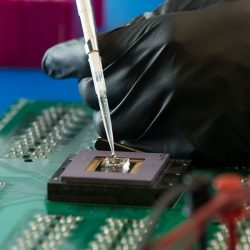
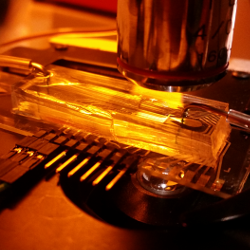
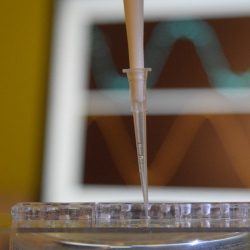
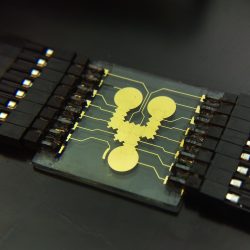
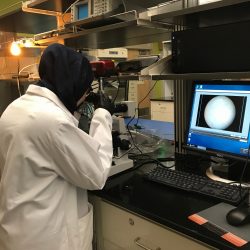






Hand-Held and Battery Operated Automated Sample Preparation System for Lab on Chip / Point of Care Applications
There have been many technological advances in the medical industry over the years giving doctors and researchers more information than ever before. Technology has allowed more sensitive and accurate sensors and has also driven the size of many devices smaller and smaller. However, while many aspects of technology have seen improvements, the sample preparation of biological tests has seen minor development. The sample prep for a test may, at first, seem insignificant, however, it is mainly what keeps many tests in the lab instead of where it may be more useful. Take, for example, the time when a doctor requires blood work be completed to determine if a patient has an infectious disease. A blood sample will be taken and sent to a lab for analysis where a trained lab technician will extract the desired features from the blood, like DNA, by mixing specific amounts of different chemicals together in a specific sequence. Once all features are extracted, the samples are placed on an instrument for analysis where results are provided relatively quickly. This process can be improved by automating the sample preparation and combining it with the advanced sensor technology to create a single, easy to use device. A primary focus of my research is not only automate the sample preparation process, but shrink it down so that portable devices can be created and bring lab quality tests to the patient bedside or areas with limited resources.
The sample prep for a test may, at first, seem insignificant, however, it is mainly what keeps many tests in the lab instead of where it may be more useful. Take, for example, the time when a doctor requires blood work be completed to determine if a patient has an infectious disease. A blood sample will be taken and sent to a lab for analysis where a trained lab technician will extract the desired features from the blood, like DNA, by mixing specific amounts of different chemicals together in a specific sequence. Once all features are extracted, the samples are placed on an instrument for analysis where results are provided relatively quickly. This process can be improved by automating the sample preparation and combining it with the advanced sensor technology to create a single, easy to use device. A primary focus of my research is not only automate the sample preparation process, but shrink it down so that portable devices can be created and bring lab quality tests to the patient bedside or areas with limited resources.
 This research focuses on liquid manipulation using a technique known as Electro-Wetting on Dielectric (EWOD). Using the principles of dielectrophoresis, liquid droplets are attracted to charge concentrations. By controlling which locations of the test chip get charged and when, a wide range of sample prep possibilities could be offered. Each chip is designed to accommodate all reagents for the assay desired. All that is left for the user to do is load the chip with any sample liquid, and press “Go” on the device. Once a test chip is available, the device has on board memory to store a variety of test protocols which can be managed via a PC through USB. An integrated rechargeable lithium ion battery provides hours of operating time.
This research focuses on liquid manipulation using a technique known as Electro-Wetting on Dielectric (EWOD). Using the principles of dielectrophoresis, liquid droplets are attracted to charge concentrations. By controlling which locations of the test chip get charged and when, a wide range of sample prep possibilities could be offered. Each chip is designed to accommodate all reagents for the assay desired. All that is left for the user to do is load the chip with any sample liquid, and press “Go” on the device. Once a test chip is available, the device has on board memory to store a variety of test protocols which can be managed via a PC through USB. An integrated rechargeable lithium ion battery provides hours of operating time.
One of the applications to demonstrate the utility of our system is DNA isolation. A custom program was created to accommodate the activation sequences in the protocol, and an embedded magnet was incorporated into the device design. The MES (2-(N-morpholino) ethanesulfonic acid) buffer, sample DNA, and magnetic beads were mixed at the appropriate ratios and then transported to the magnetic area to let the DNA bound beads precipitate from the surrounding supernatant. Once separated, the supernatant containing any unbound DNA is moved to the waste reservoir and discarded. Tris buffer is then moved through the magnetic area to elute the DNA from the beads, while leaving the beads in the magnetic area. The following photo shows the assignment of different parts of the digital microfluidic chip for this application.
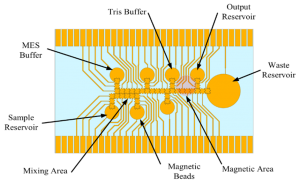
The results of DNA isolation is shown below from the plate reader results for the magnetic bead protocol. The intensity of the sample DNA was 77,616 while the intensity of the output was 72,054, suggesting a recovery of 92.8%.
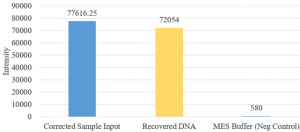
The research completed so far has focused on identifying liquids capable of movement, nucleic acid isolation, and reducing manufacturing variations to improve reliability. A complete 64 position proof of concept device was developed that allows us to test various protocol designs quickly. We are currently in the process of building 128 position device that better demonstrates the full capabilities. The next step is to integrate one of the many sensors developed in the BLISS lab to show a complete Point of Care pathogen detection device.
Walter Scott, Jr. College of Engineering
www.engr.colostate.edu
700 Meridian Ave
1301 Campus Delivery
Fort Collins, CO 80523-1301
(970) 491-3366
School of Biomedical Engineering
www.engr.colostate.edu/sbme
700 Meridian Ave
1376 Campus Delivery
Fort Collins, CO 80523-1376
(970) 491-7157
Walter Scott, Jr. College of Engineering
www.engr.colostate.edu
700 Meridian Ave
1301 Campus Delivery
Fort Collins, CO 80523-1301
(970) 491-3366
School of Biomedical Engineering
www.engr.colostate.edu/sbme
700 Meridian Ave
1376 Campus Delivery
Fort Collins, CO 80523-1376
(970) 491-7157

